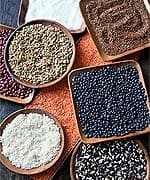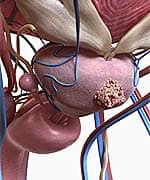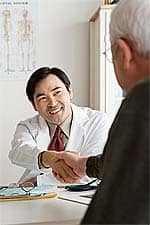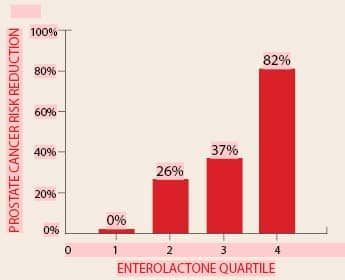Life Extension Magazine®
It would be simple if just one compound was shown to totally prevent prostate cancer. The scientific facts, however, reveal that reducing one’s risk of this epidemic killer requires a multi-pronged approach. Life Extension members already consume nutrients that have been shown in numerous studies to reduce prostate cancer risk. Yet as we age and more gene mutations accumulate in vulnerable prostate cells, there is a need to block additional mechanisms that enable cells to transform (or evolve) into malignant tumors. Natural plant lignans have demonstrated remarkable multifaceted properties against the development and progression of prostate cancer, a disease that is poised to become the most common malignancy striking aging men. While potentially effective drugs like Avodart® cost over $1,000 a year, these novel lignans have been added at no additional charge to a formula used by most male Life Extension members. In Japan and China, the incidence rates of prostate cancer are almost 10-fold less than those reported in the United States and Europe.1 Scientific studies indicate that what we eat significantly influences the incidence and mortality of prostate cancer.2-8 The lifestyle differences between East and West are considered major risk factors for developing prostate cancer. Traditional Japanese and Chinese diets are rich in foods such as fruits, vegetables, grains, and seeds—rich sources of lignans—whereas the typical Western diet tends to be a poor source of lignan compounds. It now appears that these lignans may play a role in the prevention and treatment of prostate cancer. Why You Want High Blood Levels of EnterolactonesIn response to eating certain plant foods, the intestine converts their lignans into compounds called enterolactones, which enter the bloodstream. Findings from human and animal studies indicate that these enterolactones protect against hormone-dependent cancers via several well-established mechanisms.9-11
In a large Swedish study involving 1,499 prostate cancer patients and 1,130 controls, blood (serum) levels of enterolactones were measured.12 Men with the highest serum enterolactone concentration (fourth quartile) were 82% less likely to have prostate cancer compared with men in the lowest quartile. Men in the second and third quartiles of enterolactone levels were 26% and 37% less likely to have prostate cancer, thus showing a definitive dose-response risk reduction with increasing enterolactone blood levels. A similar study conducted in Scotland on 433 prostate cancer cases with 483 men serving as controls showed that men with the highest serum enterolactone levels were 60% less likely to have prostate cancer compared with men who had the lowest levels.13 This study also showed that men who consumed the most soy foods were 48% less likely to have prostate cancer. The doctors who conducted this study concluded: “This study supports the hypotheses that soy foods and enterolactone metabolised from dietary lignans protect against prostate cancer in older Scottish men.”13 A diet-based study conducted in western New York evaluated 433 prostate cancer patients and 538 controls.14 The findings showed a 34% risk reduction in the group consuming the highest amount of enterolactone-precursor lignan foods. These diet-questionnaire studies can sometimes be inaccurate, but this one helps confirm the more precise Swedish and Scottish studies showing prostate cancer risk reductions of 82% and 60%, respectively, in men with the highest serum enterolactone levels. Treating Human Prostate Cancer in MiceOne way of identifying anticancer compounds is to test them against human tumor cells that have been injected into mice. A group of mice were inoculated with human prostate cancer cells to ascertain the effects produced by dietary administration of two different doses of the hydroxymatairesinol (HMR) plant lignan.15
Compared with the higher-dose HMR lignan group, the lower-dose group had a 259% greater tumor volume. Furthermore, mice given the higher-dose HMR lignan in their daily food had a dramatic 360% greater apoptotic index compared with the control group.15 Apoptosis is the natural termination of defective cells. Cancer cells are resistant to natural destruction, making them difficult to eradicate. The ultimate goal of most treatment modalities is to induce cancer cell apoptosis. In comparison to the lower-dose HMR lignan group, the control group mice (receiving no lignans) had 260% greater tumor volume. Mice given the lower-dose HMR lignan had a 353% greater tumor cell apoptotic index compared with the no-lignan group. Moreover, in the group receiving the higher lignan dose, the cell proliferation index was reduced by 21%, compared with the control group not receiving any lignans.15 Anti-tumor effects were also observed when HMR lignans were administered in animals to evaluate their effects on mammary (breast), liver, intestinal, and uterine tumor development.16-19 How Lignans Protect Against CancerThe primary benefit of lignan consumption is to increase blood levels of enterolactone. Enterolactone is produced during the metabolism of plant lignans by the intestinal bacteria. Scientists have conducted extensive research to ascertain why enterolactones are so effective against prostate and other cancers. A number of studies show that the increase in estrogen that occurs in aging men is a culprit in the development of both benign prostate enlargement and prostate cancer.20-23 Enterolactone functions via several mechanisms to reduce estrogen levels.
Enterolactone inhibits the aromatase enzyme that is responsible for converting testosterone into estradiol (a potent estrogen).24,25 Aging men often take expensive aromatase-inhibiting drugs (such as Arimidex®) to improve sexual performance, desire, and satisfaction and to help lose belly fat. By inhibiting the aromatase enzyme, aging men can reduce excess estrogen while simultaneously increasing beneficial free testosterone. Higher free testosterone levels have been shown to reduce the risk of a number of age-related disorders.26-30 Enterolactone may also reduce estrogen levels by inhibiting its binding to its primary protein carrier called sex hormone-binding globulin (SHBG). This enables the liver to more efficiently accelerate the natural metabolic clearance of estrogen.31 Among the three major estrogen hormones (estrone, estradiol, and estriol) produced by the human body, estradiol (E2) is the most potent, and its levels are often too high in aging men’s bodies. Enterolactone inhibits the enzymes called 17-beta hydroxysteroid dehydrogenases (HSDs), which are responsible for the conversion of estrone (E1) into estradiol (E2).32
Another enzyme involved in both benign and malignant prostate disease is 5-alpha reductase. The 5-alpha reductase enzyme converts beneficial testosterone into a potent metabolite called dihydrotestosterone (DHT). DHT provokes a potent stimulatory effect on both benign and malignant prostate cells.33 The reason Life Extension has long recommended FDA-approved drugs like Proscar® and Avodart® is that they inhibit 5-alpha reductase and thus lower DHT levels. (Avodart® is more effective than Proscar®, but consumers can now purchase a much less expensive generic version of Proscar® called finasteride.) The enterolactones have been shown to inhibit 5-alpha reductase,34 thus reducing levels of DHT, which causes so much prostate discomfort in aging men. We still don’t know exactly how effective the ingestion of plant lignans (and their subsequent conversion to enterolactones) will be in lowering DHT. Men who are prescribed Proscar® or Avodart® should continue taking their drug until we know for certain how much DHT reduction will occur in response to ingestion of standardized plant lignans.
Cancer cells utilize the tyrosine kinase enzymes to fuel their rapid growth. Metastatic prostate cancer cells were shown in one study to overexpress tyrosine kinases by 10- to 100-fold as compared with normal prostate epithelial cells.35 Enterolactone helps to inhibit the tyrosine kinase enzyme.36 Finally, enterolactone has been shown to inhibit angiogenesis (growth of new blood vessels into tumors) and promote cancer cell apoptosis (destruction) in animal models of hormone-related cancers, such as prostate cancer.37,38 How to Boost Your Blood Levels of EnterolactoneIncreasing your intake of fruits, vegetables, and whole grains helps provide the lignans needed to boost serum enterolactone levels. This fact helps explain why men who eat healthier diets enjoy sharply reduced rates of prostate cancer. The two most important lignans that most readily convert to beneficial enterolactones in the body are secoisolariciresinol diglucoside and hydroxymatairesinol. Extracts obtained from flax (ActiFlax™) and the Norway spruce (HMRlignan™) are now available as concentrated dietary supplements to enable aging men to achieve and maintain higher daily blood levels of enterolactones. Foundation members using a popular prostate health formula will automatically be obtaining a standardized full spectrum blend of these versatile plant lignans to raise their serum enterolactone levels. If you have any questions on the scientificcontent of this article, please call a Life Extension Health Advisor at 1-800-226-2370.
| ||||||||
| References | ||||||||
| 1. McCann MJ, Gill CI, McGlynn H, Rowland IR. Role of mammalian lignans in the prevention and treatment of prostate cancer. Nutr Cancer. 2005;52(1):1-14. 2. Bosetti C, Tzonou A, Lagiou P, et al. Fraction of prostate cancer incidence attributed to diet in Athens, Greece. Eur J Cancer Prev. 2000 Apr;9(2):119-23. 3. Schuurman AG, van den Brandt PA, Dorant E, Goldbohm RA. Animal products, calcium and protein and prostate cancer risk in The Netherlands Cohort Study. Br J Cancer. 1999 Jun;80(7):1107-13. 4. Grant WB. An ecologic study of dietary links to prostate cancer. Altern Med Rev. 1999 Jun;4(3):162-9. 5. Giovannucci E, Rimm EB, Wolk A, et al. Calcium and fructose intake in relation to risk of prostate cancer. Cancer Res. 1998 Feb 1;58(3):442-7. 6. Chan JM, Giovannucci E, Andersson SO, et al. Dairy products, calcium, phosphorous, vitamin D, and risk of prostate cancer (Sweden). Cancer Causes Control. 1998 Dec;9(6):559-66. 7. Veierod MB, Laake P, Thelle DS. Dietary fat intake and risk of prostate cancer: a prospective study of 25,708 Norwegian men. Int J Cancer. 1997 Nov 27;73(5):634-8. 8. De Stefani E, Fierro L, Barrios E, Ronco A. Tobacco, alcohol, diet and risk of prostate cancer. Tumori. 1995 Sep;81(5):315-20. 9. Saleem M, Kim HJ, Ali MS, Lee YS. An update on bioactive plant lignans. Nat Prod Rep. 2005 Dec;22(6):696-716. 10. McCann SE, Muti P, Vito D, et al. Dietary lignan intakes and risk of pre- and postmenopausal breast cancer. Int J Cancer. 2004 Sep 1;111(3):440-3. 11. Wang LQ. Mammalian phytoestrogens: enterodiol and enterolactone. J Chromatogr B Analyt Technol Biomed Life Sci. 2002 Sep 25;777(1-2):289-309. 12. Hedelin M, Klint A, Chang ET, et al. Dietary phytoestrogen, serum enterolactone and risk of prostate cancer: the cancer prostate Sweden study (Sweden). Cancer Causes Control. 2006 Mar;17(2):169-80. 13. Heald CL, Ritchie MR, Bolton-Smith C, Morton MS, Alexander FE. Phyto-oestrogens and risk of prostate cancer in Scottish men. Br J Nutr. 2007 Aug;98(2):388-96. 14. McCann SE, Ambrosone CB, Moysich KB, et al. Intakes of selected nutrients, foods, and phytochemicals and prostate cancer risk in western New York. Nutr Cancer. 2005;53(1):33-41. 15. Bylund A, Saarinen N, Zhang JX, et al. Anticancer effects of a plant lignan 7-hydroxymatairesinol on a prostate cancer model in vivo. Exp Biol Med (Maywood). 2005 Mar;230(3):217-23. 16. Oikarinen SI, Pajari A, Mutanen M. Chemopreventive activity of crude hydroxymatairesinol (HMR) extract in Apc(Min) mice. Cancer Lett. 2000 Dec 20;161(2):253-8. 17. Kangas L, Saarinen N, Mutanen M, et al. Antioxidant and antitumor effects of hydroxymatairesinol (HM-3000, HMR), a lignan isolated from the knots of spruce. Eur J Cancer Prev. 2002 Aug;11 Suppl 2S48-S57. 18. Miura D, Saarinen NM, Miura Y, Santti R, Yagasaki K. Hydroxymatairesinol and its mammalian metabolite enterolactone reduce the growth and metastasis of subcutaneous AH109A hepatomas in rats. Nutr Cancer. 2007;58(1):49-59. 19. Katsuda S, Yoshida M, Saarinen N, et al. Chemopreventive effects of hydroxymatairesinol on uterine carcinogenesis in Donryu rats. Exp Biol Med (Maywood). 2004 May;229(5):417-24. 20. Takase Y, Levesque MH, Luu-The V, et al. Expression of enzymes involved in estrogen metabolism in human prostate. J Histochem Cytochem. 2006 Aug;54(8):911-21. 21. Bonkhoff H, Fixemer T. Implications of estrogens and their receptors for the development and progression of prostate cancer. Pathologe. 2005 Nov;26(6):461-8. 22. Yang GS, Chen ZD. Comparative studies of the expression of estrogen receptor-alpha and estrogen receptor-beta in prostatic carcinoma. Zhonghua Wai Ke Za Zhi. 2004 Sep 22;42(18):1111-5. 23. Steiner MS, Raghow S. Antiestrogens and selective estrogen receptor modulators reduce prostate cancer risk. World J Urol. 2003 May;21(1):31-6. 24. Brooks JD, Thompson LU. Mammalian lignans and genistein decrease the activities of aromatase and 17beta-hydroxysteroid dehydrogenase in MCF-7 cells. J Steroid Biochem Mol Biol. 2005 Apr;94(5):461-7. 25. Wang C, Makela T, Hase T, Adlercreutz H, Kurzer MS. Lignans and flavonoids inhibit aromatase enzyme in human preadipocytes. J Steroid Biochem Mol Biol. 1994 Aug;50(3-4):205-12. 26. Simon D, Charles MA, Lahlou N, et al. Androgen therapy improves insulin sensitivity and decreases leptin level in healthy adult men with low plasma total testosterone: a 3-month randomized placebo-controlled trial. Diabetes Care. 2001 Dec;24(12):2149-51. 27. Malkin CJ, Pugh PJ, Jones RD, et al. The effect of testosterone replacement on endogenous inflammatory cytokines and lipid profiles in hypogonadal men. J Clin Endocrinol Metab. 2004 Jul;89(7):3313-8. 28. Rosano GM, Sheiban I, Massaro R, et al. Low testosterone levels are associated with coronary artery disease in male patients with angina. Int J Impot Res. 2007 Mar;19(2):176-82. 29. Bolona ER, Uraga MV, Haddad RM, et al. Testosterone use in men with sexual dysfunction: a systematic review and meta-analysis of randomized placebo-controlled trials. Mayo Clin Proc. 2007 Jan;82(1):20-8. 30. Aversa A, Isidori AM, Spera G, Lenzi A, Fabbri A. Androgens improve cavernous vasodilation and response to sildenafil in patients with erectile dysfunction. Clin Endocrinol (Oxf). 2003 May;58(5):632-8. 31. Hutchins AM, Martini MC, Olson BA, Thomas W, Slavin JL. Flaxseed consumption influences endogenous hormone concentrations in postmenopausal women. Nutr Cancer. 2001;39(1):58-65. 32. Krazeisen A, Breitling R, Moller G, Adamski J. Phytoestrogens inhibit human 17beta-hydroxysteroid dehydrogenase type 5. Mol Cell Endocrinol. 2001 Jan 22;171(1-2):151-62. 33. Available at: http://en.wikipedia.org/wiki/5-alpha-reductase_deficiency. Accessed October 18, 2007. 34. Evans BA, Griffiths K, Morton MS. Inhibition of 5 alpha-reductase in genital skin fibroblasts and prostate tissue by dietary lignans and isoflavonoids. J Endocrinol. 1995 Nov;147(2):295-302. 35. Walker-Daniels J, Coffman K, Azimi M, et al. Overexpression of the EphA2 tyrosine kinase in prostate cancer. Prostate. 1999 Dec 1;41(4):275-80. 36. Denis L, Morton MS, Griffiths K. Diet and its preventive role in prostatic disease. Eur Urol. 1999;35(5-6):377-87. 37. Bergman JM, Thompson LU, Dabrosin C. Flaxseed and its lignans inhibit estradiol-induced growth, angiogenesis, and secretion of vascular endothelial growth factor in human breast cancer xenografts in vivo. Clin Cancer Res. 2007 Feb 1;13(3):1061-7. 38. Chen LH, Fang J, Li H, Demark-Wahnefried W, Lin X. Enterolactone induces apoptosis in human prostate carcinoma LNCaP cells via a mitochondrial-mediated, caspase-dependent pathway. Mol Cancer Ther. 2007 Sep;6(9):2581-90. |






